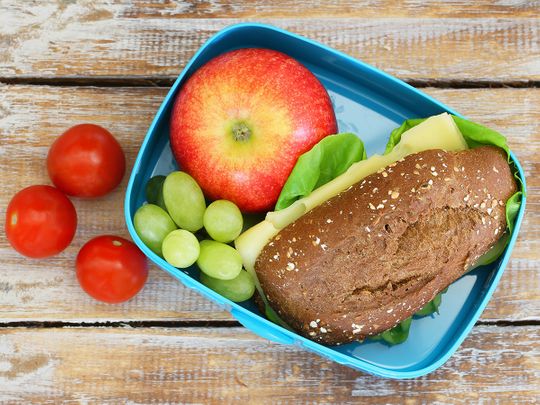Pack a healthy punch
[ad_1]

After months of home schooling, parents have had to think about healthy packed lunches. Many are focused on strengthening their children’s immune system, while keeping their children alert and active over the long day away.
“These unprecedented times have given us the opportunity to re-examine our wellbeing and lifestyle. There’s been much more focus on how the family contributes towards shaping a healthy future for kids,” says Dr Remy Shanker, a UAE-based medical doctor who specialises in nutrition in her role as Wellness Specialist at New York University Abu Dhabi.
“I think the year’s restrictions have presented the unique opportunity to think about how meal prep can be quite efficient with kids enjoying a nutritive process from scratch,” she says. “We can now reimagine lunch boxes with less frequent processed foods and the re-emergence of the simple and humble home cooked meal that celebrates a family’s culture, supports local produce, involves a mindful practice of knowing what goes into our bodies and uplifts the wellbeing of the family.”
Dubai Health Authority’s (DHA’s) school nutrition programme is built around the Healthy Plate concept, which seeks to educate residents about what students should be eating and when.
“We educate all stakeholders on what students need for different meal times, all the major food groups to be included in their meals, what to carry in their lunch box and how many servings of fruits and vegetables they need in a day. We educate them about having lean protein, whole milk, saying no to sweetened drinks and remaining well hydrated,” Dr Waffa Ayesh, DHA’s director of clinical nutrition, told Gulf News previously.
Plan lunch boxes according to the food groups
Parents need to remember that they are packing a lunch box, she says. “Lunch is a meal and not a snack. Hence, parents should refrain from packing a snack instead of a meal. Every meal, whether breakfast, lunch, or dinner, should have all five food groups in the right proportions: fruits, vegetables, grain, protein, and dairy.”
Fruit, vegetables and whole grains are a valuable source of nutrients and minerals. As a source of healthy carbohydrates, they fuel the body with energy, while providing fibre to regulate insulin spikes and fluctuations.
Proteins such as meat, legumes and beans, provide the building blocks for muscles and different kinds of cells. Because they promote satiety, you feel full for longer after eating them.
Healthy fats, meanwhile, are essential for survival, growth and development. They work to insulate the body and are essential for building hormones, while serving as a carrier to help absorb vitamins.
Put the focus on health
Taking a cue from DHA, Dr Caecilia Verlinden, a specialist in Family Medicine at the multi-specialty Dr Roze & Associates Clinics in Dubai’s Umm Suqeim area, says a health lunch can energise kids and enhance their learning abilities and creativity.
She suggests dividing the box – or plate – into four. “As a rule of thumb, it’s better to have half of your plate filled with vegetables and fruits. For the fibre content in your meal, make sure you wash your fruit and veggies but try to leave the skin on when they have eatable skins. When it comes to protein, which is important for physical activities and for learning, fill a quarter of the lunch box with dairy or meat/poultry products, but think about adding lentils, beans or peas.
For the last quarter of the box you can add carbohydrates, for example rice, pasta, bread or other tasty grains. Preferably, make sure the carbs are whole wheat products, i.e. brown rice, multi grain bread or whole wheat pasta. I also always recommend that my patients add mint, cucumbers or citrus fruits to bottled water in order to more palatable,” Dr Verlinden says.
Skip processed and packaged snacks
All too frequently, parents fill lunch boxes with pre-packed snacks that are widely marketed as “school lunch box ready”. Often labelled raw, natural, sugar-free, healthy, high-protein, or promoted as made with whole grains or real fruits, in reality they’re often unhealthy items crammed with empty calories. “Single-use pre-packed snacks became popular features in lunch boxes at a time when convenience foods were marketed to target the changing landscape of working parents. “It’s easier to throw things into a lunch box that are considered to be less time consuming, cheap, and easily available,” says Dr Remy.
The truth about these items is less palatable: you’re trading health for convenience. “Generally, packaged single-use snacks can be laden with proinflammatory trans fats, refined vegetable oils, refined sugars in many different forms, additives and preservatives to increase shelf life and compliment mass-manufacture machine hygienics.
But consuming these on a regular basis typically lead to a litany of juvenile lifestyle chronic diseases which have their own adverse health implications while making individuals susceptible to other infections. While convenience food has all the tricks of gimmicky marketing strategies up their sleeve, it is up to us as consumers to carefully read the fine print of ingredients and deliberate the traffic of such products in our households to a minimal frequency.”
As a final recommendation, she says it’s worth remembering to pack a variety of different foods. “Eating the rainbow helps boost immunity and overall wellbeing,” Dr Remy says. For a quick hack, make a note on a kitchen board or on your phone of what you’ve packed for your kids each day – within a week you’ll have an overview of what they’re eating and where to make changes.”
[ad_2]
Source link

